How awesome would it be if your business could continue growing while you slept? You’ve surely heard this promise before. Maybe you’ve tried using the Internet in the past by building a website, but never got the traffic you were expecting. Or you created a few social media profiles, but quickly discovered how difficult it is to turn “likes” into paying customers. And perhaps you’ve even spent some money on Google AdWords and banner ads with varying degrees of success. The truth is, without the right strategy in place none of these tactics will get you the results you’re after. As a business owner, you have the passion to build your business, but you’re limited by time, resources, and knowledge. You know that Digital Marketing could bridge the gap between where you are and where you want to be, but you're not sure where to begin.
If you’re ready to jumpstart your growth and increase sales leads without increasing your workday, then the Internet and content marketing is the road you must travel.
What is Content Marketing
What is Content Marketing? In its simplest sense, content marketing is creating and distributing information that’s valuable to your prospects, to encourage them to interact with your brand in a certain way. When done right, it paves the way to new business by:
- increasing your sales,
- increasing repeat business,
- generating word of mouth,
- and positioning your brand as an industry expert.
The Internet and content marketing road has been heavily trafficked. In years past, B2B companies have been heavy investors in content marketing, and they still are today with 93 percent using content marketing. Did you know that B2C companies have also joined the trek? An end of 2013 study concluded that approximately 86 percent of B2C companies use content marketing. Due to the number of consumers turning to social media to make buying decisions, business-to-consumer companies now see content marketing as the key to expanding their client base, regardless of industry or niche. This begs the question: why content marketing?
Why Content Marketing?
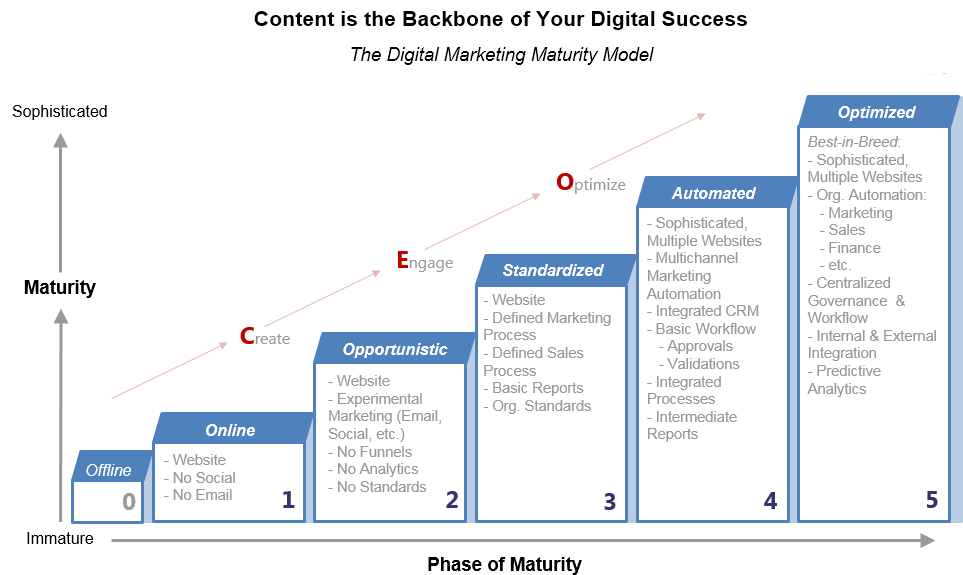
Did you know that 62% of all searches online are informational? Content is the key to turning your prospects curiosity into sales leads for your business. Download our guide to learn how to move from step 0 or 1 on the Digital Marketing Maturity Model above to step 2, and lay the groundwork for accelerating your growth to the top of the digital marketing staircase.
What You’ll Learn in This Guide
- Section 1: Why Content Marketing?
- Section 2: Designing Your First Article
- Step 1: Understand Your Audience
- Step 2: Generate Ideas
- Step 3: Keyword Research
- Step 4: Outline Your Article
- Section 3: Creating Your Article
- Creating Killer Content
- Adding Visual Appeal
- Section 4: Engaging Your Audience
- Building In Your Calls to Action
- Section 5: Optimizing Your Results
- Google Analytics: A Crash Course
- Staying Agile
- Section 6: Summary
- Preparing For Tomorrow
Section 1: Why Content Marketing?
When was the last time you paid attention to a TV commercial, or a radio ad? Generally, we forget these quickly because of the overwhelming amount of information we are bombarded with every day. Not to mention ad blocker sophistication has created a virtually unreachable audience through many traditional advertising channels. On the other hand, we all hunger for information, which means we aren’t as unreachable as we may appear. This is where content marketing comes in.
Businesses opting to leverage an education based marketing approach are actively earning more customers, stronger loyalty, and higher sales. Instead of bombarding their audience with propaganda or repeated calls to action, the content teaches and offers a solution that includes a call to learn more. Instead of pushy sales, businesses win customer trust right alongside their loyalty and conversion. And here’s how well it’s working:
- Business with an active blog generate about 67 percent more leads per months than those that rarely, if ever, blog.
- Businesses that blog at least 15 times each month gain five times more traffic than those that don’t.
On average, over 27 million pieces of content are shared on the Web each day. The sheer volume of content hitting the Internet backs up the truth that people crave content, but they aren’t mindlessly sharing whatever happens to grace their social media feeds. They’re on the hunt for a specific kind of information.
Content marketing in its various forms, from blog articles to presentations, can fuel social web while singlehandedly increasing engagement and brand loyalty. It generates more leads, and when it’s done right, those generated leads are of high quality.
Does your brand silence the noise of those 27 million pieces of content flooding the Internet each day, or do you fall into it? In the next few sections, you’re going to learn exactly how to jumpstart your brand with content marketing by writing your first article.
The approach you’re about to wield is known as the CEO Framework™. CEO stands for Create, Engage, and Optimize:
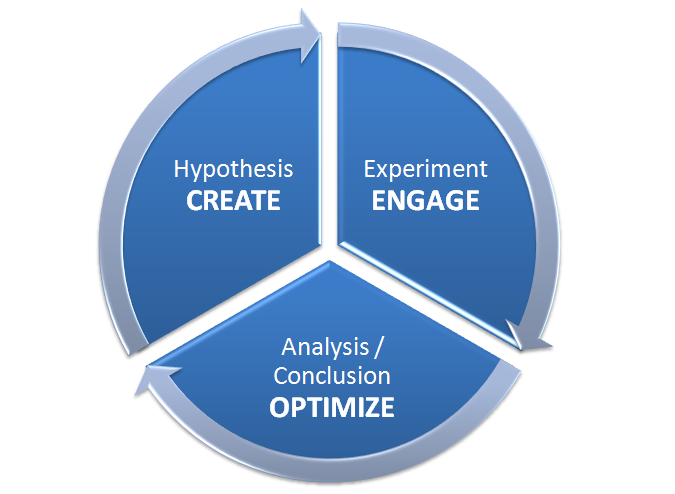
The CEO Framework™ is the perfect launching platform for the beginner content marketer because it uses the top three content strategies. In the following sections, we’ll discuss how to create your first article, use it to engage your audience, and build in elements that will allow for easy optimization. You will learn how to test your results while collecting data, thus seeing what works and creating your own competitive advantage.
Section 2: Designing Your First Article
Before you can effectively engage or optimize, you must first create. The backbone of content marketing is content. Let’s say that you’re the owner of a pet store. You specialize in birds—a niche within your industry. As you begin to create content, your first step will be to understand your audience.
Step 1: Understand Your Audience
Successful content hinges on understanding your audience. They should forever be the focus of your marketing plan, and every piece of content you create must cater to their needs. Before brainstorming content ideas, profile your audience. Ask yourself:
- What issues are important to my audience, and what kind of solution are they seeking?
- What information, including facts and statistics, will be of interest to my audience?
- What drives my audience?
- What benefit and value can I offer them?
Let’s return to our pet store for a moment. As you attempt to understand your audience, you discover where they hang out online and what’s important to them. You notice populated and talkative Facebook groups, forums, social media pages, etc. and you start seeing a few blogs run by influencers in the market—experts your target audience trusts. You take note of the topics that are important to them, and document the influencers they pay attention to. You will be wise to reach out to those influencers and nurture a relationship because they will be instrumental later on.
Step 2: Generate Ideas
As you research and learn about your audience, you will likely find ideas for content popping into your head. Idea generation is all about brainstorming relevant content that can later become highly engaging. As you brainstorm ideas, do research. Visit your competitors’ websites. Surf their blogs. Find out what the experts in your industry or niche are talking about, and research trending topics or issues. A news feed dedicated to your niche can be a prime source for generating relevant ideas.
Find your target audience’s hangouts and discover their interests.
Let’s apply this to our pet store. We’ve been researching and learning about our bird loving audience, and we’ve discovered that these pet owners are concerned about topics that revolve around proper care and healthfactors for birds. There’s a lot of chatter in forums and groups about where to find specific care products. Logically, we begin to consider how our business can meet these needs. Articles about bird care and products we carry would likely appeal to our audience.
Next, we brainstorm topics. As you can imagine, this step takes time. Remember, the more the article resonates with your audience and gives them relevant information, the more they will share it. It’s better to spend more time on steps one and two to come up with a better article, then to focus more heavily on the following steps. Moreover, it will help you later in writing your article.
Step 3: Keyword Research
The days of keyword stuffing are dead, but keyword research is still relevant. High quality content is instant search engine optimization (SEO), but you’ll still need to incorporate keywords. You can determine which keywords to target by using Google Keyword Planner.
If you don’t already have one, you’ll need to create a free Google AdWords account. Once you’ve created it and logged in, you’ll be ready to find keywords. Here’s how we would research keywords for our pet store:
- On the keyword tool home page, enter in key phrases separated by commas, such as “pet store in NJ, pet store in New Jersey, pet stores in New Jersey, bird food.” Then, click “Get ideas.”
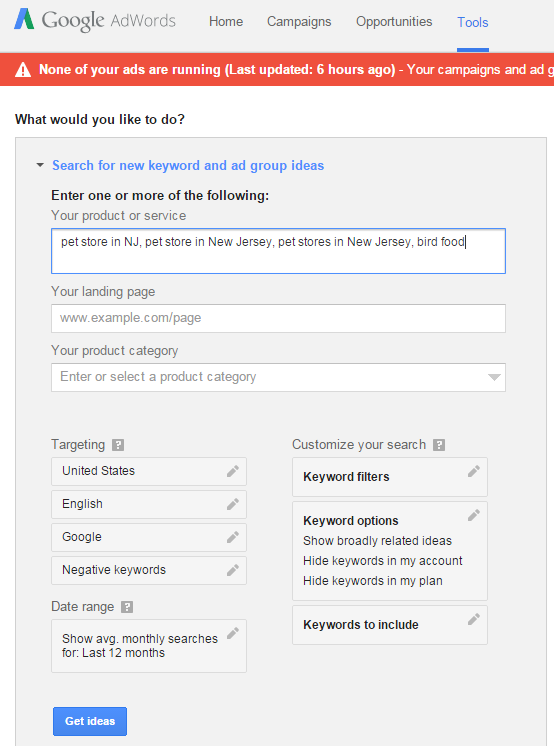
- Next, click on the “Keyword Ideas” tab. Notice the average number of searches, competition, and suggested bid amounts. These elements provide a sense of how hard it may be to place organically for a certain keyword. Notice how slightly different spellings of the same word could result in higher or lower competition, i.e. “NJ” versus “New Jersey” and “store” versus “stores.”
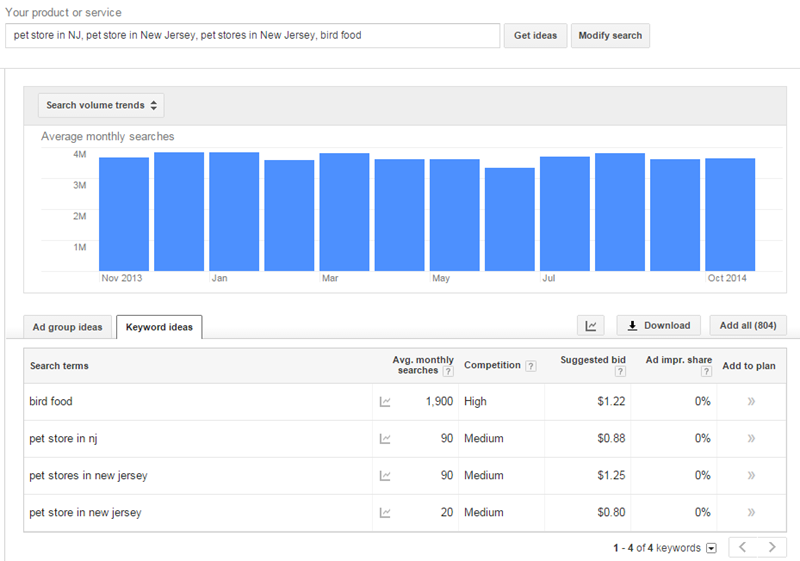
- Now, take the same keywords and search for each of them in Google. Notice the number of search results displayed at the top. This, combined with the information from the previous step, will give you a pretty good idea of how competitive a keyword is.
Notice the difference between the numbers of results in the two queries above.
- You can also use the table below your “Keyword Ideas” i.e. “Keyword (by relevancy)…” to find other ideas for keywords. Sort this table by the average number of searches or competition to try and find the best keywords. Your goal is to find the keywords with the highest number of searches and the lowest amount of competition that are highly relevant to your niche.
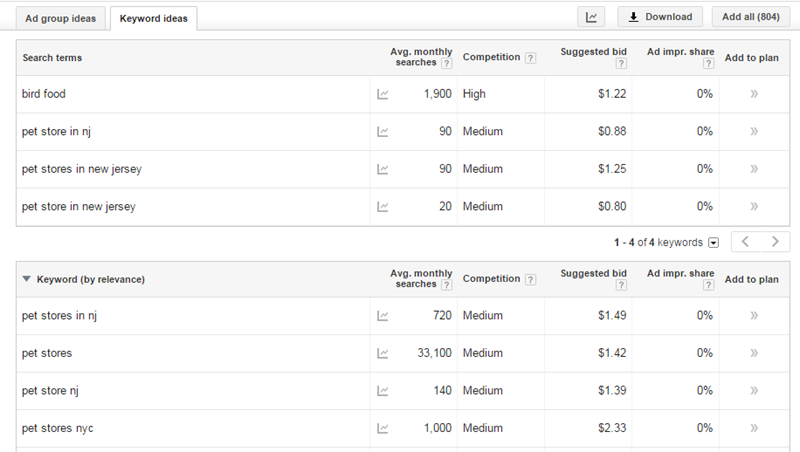
Once you’ve completed these steps, you’re ready to leverage the list of results to determine a good idea for your article. The keywords that meet the criteria of many searches, low competition, and high relevancy can provide us with intent, i.e. which keywords are purely searched for informational purposes versus those geared toward making a purchase. Some keywords will revolve around both, giving us an opportunity to create informative content geared toward making a purchase, such as “harrisons bird food.” In this case, we have an opportunity to educate readers about our care products while discussing a topic that concerns them: Bird food.

Keyword Planner is a tool you can use to find keywords that are relevant to your business which are already getting search traffic. Wield it to research and pinpoint the best keywords to generate the highest quality in leads.
Step 4: Outline Your Article
Once you’ve profiled your target audience, generated article ideas, and pinpointed keywords, you’re ready to outline your article. An outline is the skeletal structure of your article. At minimum, it should house the article’s title, headings, and the main points to cover. If inspiration strikes and you find yourself inundated with detail, don’t be afraid to build those details right into your outline. There is no wrong way to create an outline!
Let’s say we decided to run with the idea of an informative, product-geared article for our pet store. Here’s what a basic outline might look like:
- The Best Bird Food in New Jersey
- Introduction
- Story reflecting the importance of quality food
- Briefly touch on how Harrison’s brand food can help
- Body
- Talk about what makes Harrison’s bird food the best
- Conclusion
- Summarize the benefits and where to find Harrison’s bird food in New Jersey
Section 3: Creating Your Article
You’ve pounded the cyber pavement, and your initial design work is complete. It’s time to create your first article, but as you sit down in front of your computer, something unexpected happens. You find yourself staring at that outline, unsure of what to do next. Thankfully, expert authors know exactly what you’re feeling right now, and they’re not shy about offering tips:
- Write Whatever Comes to Mind: The first words or sentences don’t need to be perfect. You just need to get that outline into a rough, written draft. You can edit later. Just start to write so that you find a rhythm.
- Share Yourself: Don’t be afraid to share a personal story or anecdote. That personal touch will make your article real and help readers connect.
- Eliminate Distractions: You’re writing your first article. Unless you thrive in a chaotic, loud environment, it’s a good idea to try moving somewhere void of distractions, and eliminate others by staying off Facebook or Twitter. Your goal is focus.
Creating Killer Content
Killer content is shareable content, which means the reader will want to retweet, like, and share as quickly as they finish reading. There are numerous ways to craft killer content, but these techniques are some of the most effective:
- Be A Storyteller: People love stories. They like hearing about others overcoming incredible odds or challenges. You can become the storyteller they want first by sharing yourself, and second by sharing your company.
- Choose A Strong Title: The title of your article can generate intrigue and pique curiosity. In fact, most people decide whether to read an article based on the title. Pick a strong one. If you’re having trouble, look at popular titles in your newsfeed. They can spark ideas.
- Facts, Figures, and Market Data: Incorporation of proven facts, backed up figures, and marketing data is important. These elements build credibility and authority, adding an extra layer to the “killer” side of your content.
Not sure where to start? That’s okay. Even the best writers sometimes stare a topic down, unsure of exactly how to turn it into a well-written article. If you’re a visual learner, an article template can quickly turn you into an unstoppable writing force. An Internet search for “free article templates” can produce some fast inspiration, and resource websites like EzineArticles.com are excellent sources for original templates.
The beginning to our first article for our pet store, might look something like this:
Harrison’s Bird Food – The Best Bird Food in New Jersey
Pets are an important part of our lives. Birds are some of the more difficult pets to care for. My first bird, Stan, was a learning experience, and looking back, I wish I knew then what I know now. The bird food you choose to use can affect everything from your bird’s health to their longevity, which is why it’s crucial to choose only the best. That’s why I now run Pete’s Pets. As one of the best pet stores in New Jersey, I stock only the best bird food brands for your feathered friend. Harrison’s Bird Food is one of our most popular and sought after quality feeds.
Notice the incorporation of keywords in the title and introduction (i.e. “Harrison’s Bird Food”). The opening paragraph establishes common ground with the reader and references personal experience, paving the way to weave in a real life story throughout the rest of the article—a strong means of engaging readers from start to finish. Once written, this article for Harrison’s can even be used as a template for other bird food brands, like Higgins, to attract more visitors.
Adding Visual Appeal
Once you’ve written your article, it’s time to add some visual appeal. Visual aids are one of the easiest elements to overlook when creating an article. Your audience is coming to you live from the cyber highway, and mobile is booming! Gartner predicted that mobile and tablet devices would make up more than 87 percent of 2014 sales. Fast forward to today and chances are you're probably reading this right now on your tablet or mobile phone! Most mobile users’ judge content by its visual appeal. As you create your article, keep the following guidelines in mind:
- Feature Image: Your article should include, at the very least, one high quality feature image. Think of it as an image that represents the main idea of the article.
- Images with Text: Include facts on photos. This strong marketing technique promotes audience understanding while helping conversion.
- Infographics: Another great visual aid is an infographic. These diverse graphics are deigned to impart great amounts of complex knowledge through easy to understand visual aids. An infographic can be the perfect way to summarize or explain hard-hitting facts and statistics covered within your article.
You can add numerous photos to any article, but be picky. Each photo or visual aid should contribute to the audience’s understanding of your article. Each one must be relevant, and it’s important they all be of good quality across platforms, including mobile. You can find good quality stock photos online at various places, such as Pixabay, SXC.hu, and Flickr.
Section 4: Engaging Your Audience
The ultimate goal of your content marketing is to generate new leads for your business and establish credibility and expertise for your brand. The higher the quality of the content you publish, the more people will share it and engage with it. Therefore, once your first article is ready for publication, your next goal will be to engage your audience and their influencers. You will literally be opening the door for new leads.
The first aspect to engaging you audience is social media. People love Facebook and Twitter. So, when you publish that first article that you’ve worked so hard on, share it on those platforms. But don’t simply provide a link to the article. Promote it! Give you audience a hook, an indicator about why they should be interested in that article. You have to hand them a reason to click.
Don’t limit your social sharing to Facebook and Twitter. It’s true that they are two of the largest social media networks on the Internet, but there are dozens of other social networks and platforms that your audience frequents. Be where your audience is! For example, you might also announce your article on:
- Google+
- Reddit
- Stumble Upon
- LinkedIn
- Tumblr
- Web Communities
- Forums
Find out where your audience hangs out online, and create a presence within those hangouts. But don’t forget about the power of email. Chances are you already have a sizeable email list containing your existing customers. Engage with them by sharing your articles.
Remember the audience research we conducted for our pet store in step one of Section 2? All of that research will now pay off. With article “in hand,” we can now share our content at the places our audience frequents. And we can now use the relationships we’ve built with influencers to get links and assist in sharing content.
Informative, educational articles are a key means of building credibility, especially with your existing customer base. The more actively you engage your audience with articles, the more you’ll earn customer loyalty and greater repeat business.
Building In Your Calls to Action
Your calls to action (CTA) will greatly affect audience engagement. A call to action is a call for the reader to take a specific action. For example, an article ending with, “Read more in our upcoming blog,” calls on a reader to watch for an upcoming blog. CTAs are vital elements of content because without them we won’t be able to convert the reader into a new sales lead.
A large portion of your readers may not be ready to buy now. A CTA is an easy way to generate potential future business from your audience. A CTA for our pet store owner’s article could look like one of the following, depending on the desired action:
- Sign up for our newsletter and get a free sample of Harrison’s bird food!
- Stay abreast of the best care products for your pet. Sign up for our newsletter and receive a special coupon to save off your first bag.
CTAs offering a reward for a designated action are often the most successful. The main goal should be to compel potential customers to join an e-mail list. To achieve this goal, create a MailChimp account and then embed the sign-up form within your blog post.
When setting up your MailChimp form be sure to include a custom “thank you” page. In the thank you page link you’ll want to make sure to add UTM fields. UTM fields allow you to create trackable, custom campaigns meaning once you have multiple articles you can track which ones result in the most sign-ups. To create UTM fields go to the URL builder. Here’s how we might leverage the URL builder for our pet store:
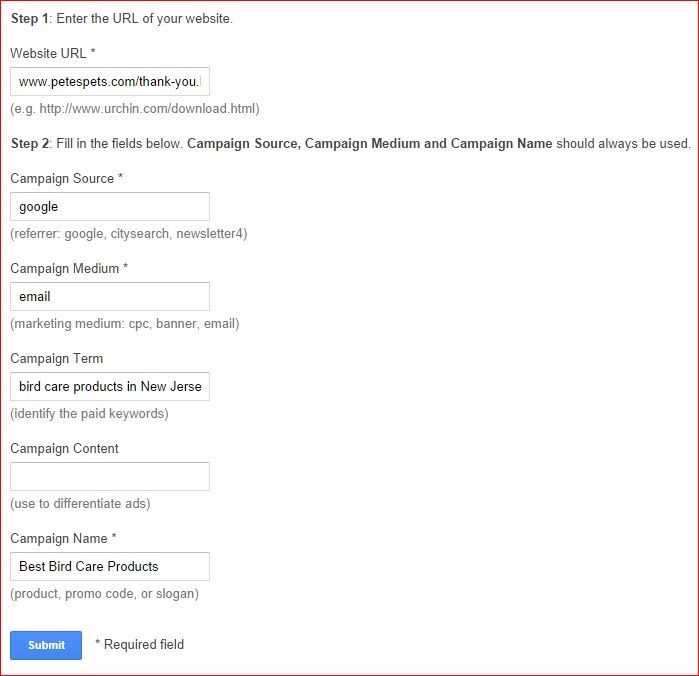
Result:

You will always supply a campaign source, medium, and name. The source will identify a search engine, newsletter name, or other source. The medium will indicate a medium, such as cost-per-click or e-mail. The name will be used for keyword analysis to identify a specific promotion or strategic campaign. Don’t skimp on these steps. They’ll assist in optimizing your results because later, when you have many articles, you will be able to see exactly which pieces of content are converting the most people into subscribers.
Section 5: Optimizing Your Results
You can step into content marketing and do everything from article design and creation to audience engagement, but you won't reach your full potential without the ability to see what's working and cut what's not; that's where analytics comes in. Some topics will produce better results than others will, and this is information you need access to. How can you track what works versus what doesn’t? Google Analytics.
A Crash Course in Google Analytics
Google Analytics is free to use. You can start analyzing your traffic in three simple steps:
- Sign up. It’s free, and Google only needs basic information about the site you’d like to monitor.
- Add a tracking code. Once you’re signed up, Google will provide a tracking code. It will need to be pasted onto your pages (and articles) in order for Google to know when your site is visited. You’ll want to add the tracking code to your most vital pages, including landing, exit, campaign, blog, and thank you pages.
- Learn about your audience. Within a few hours of adding the tracking code, you’ll start seeing data about your site.
When you log in to Google Analytics, you’ll be on the Home page. From this page, you can view a list of all the websites set up in your account. The list displays basic data including your total sessions, the average duration of each session, bounce rates, and goal conversion rates. To view more information about a particular website, simply click on the corresponding link. Next you’ll see the Google Analytics Reporting page.
From the Reporting page, you’ll have the ability to create customized dashboards, which are highly efficient for putting all of your important data into one, easy to access location. Google’s reporting will allow you to see exactly what’s happening (or not happening) on the pages you’re tracking.
Landing and exit pages are easily accessible via the Reporting page. Google will record page visits, average visit durations, new visits, and bounce rates. You can also click into your keywords to see which ones are proving fruitful. Your custom campaigns will also display on the Reporting page as a link, and you’ll be able to click into them for detailed information. The UTM fields from the previous step will allow you to see how many people signed up and ended at your campaign’s thank you page.
All of the information documented by Google Analytics—from how many people signed up to your e-mail list and ended up on a thank you page to how many people viewed your blog pages—is the very beginning to creating your own sales funnel. We’ll discuss the funnel in much greater detail in the coming book, “How to Promote Your Business Online.”
Analytics are a powerful means of determining whether or not users are following your call to action. With Google Analytics, you can pinpoint what articles are generating traffic, and which articles are getting conversions on your website. Armed with this information, you can begin to test improvements, eventually increasing your conversion rate.
Staying Agile
Agile Marketing is the ability to make decisions faster by running campaigns on a smaller scale over a shorter time, collecting test results along the way. The key to agile marketing is to collect as much data as you can, constantly trying new techniques, and document what works and what doesn’t. As you track what does and doesn’t work, use the knowledge gained to improve your next article. Update the layout, use a stronger title, change how you use headings and subheadings, increase or decrease visual aids, change how, where, and when you distribute your content, and so on. The trick is to be creative and closely monitor the results. Do the changes you make increase traffic and leads or not?
Continually test content and aesthetic changes. Document the elements that work, incorporate them into future articles, and build on it.
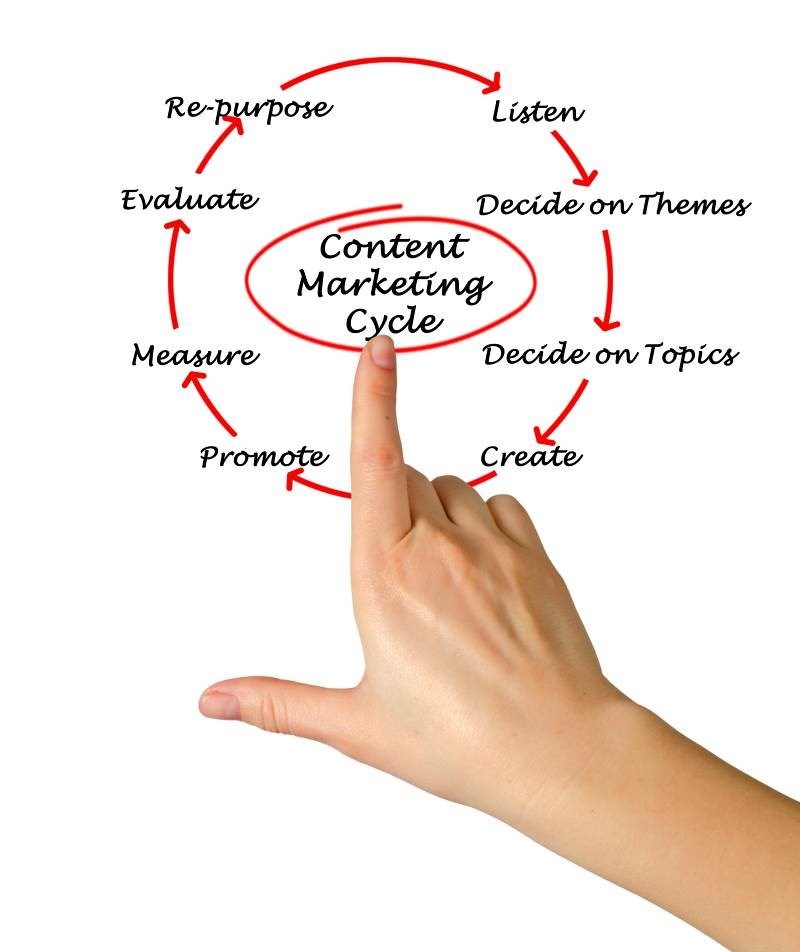
Section 6: Summary
According to Small Biz Trends, approximately 552,000 new businesses open every month. 50 percent of them will fail within the first year. 95 percent will fail within the first five years. Isn’t it time to increase the odds in your favor?
Content marketing houses the competitive edge you need to connect with your target audience and produce high quality leads, the kind that convert into sales. If you’re ready to take advantage of the power of content, it’s time to leverage the CEO Framework™ and turn traffic into revenue.
The CEO Framework™ is more than an article creation “how to” based on creation, engagement, and optimization. It’s a framework that creates the right Internet presence for a brand, promotes brand recognition, and ultimately increases leads and sales:
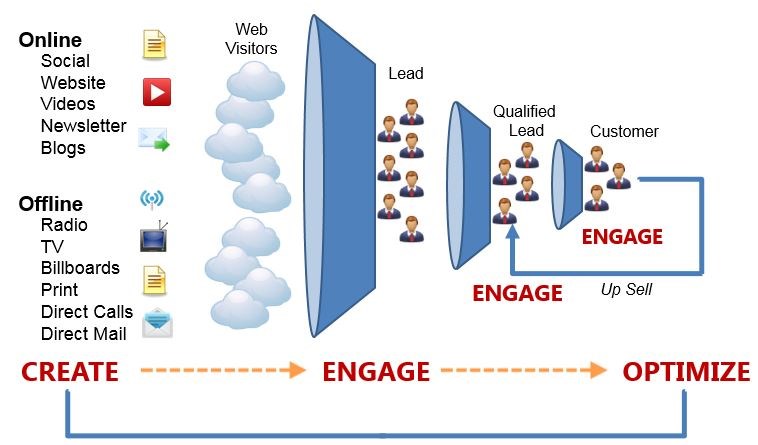
The Sales Funnel & the CEO Framework™
Content is powerful, but no matter how awesome yours is, if it’s not backed by the right strategy, it will fail to generate new leads. Why not turn your business into an agile competitor, capable of adapting to whatever trends impact your niche? That’s what the CEO Framework™ can do for you. It’s well worth your time to learn more about the CEO Framework™.
Preparing For Tomorrow
Did you know that the Internet population is more than 2.4 billion? Isn’t it time your brand stood out from the average population? Isn’t it time your content made a strong impact on your audience? Stepping into the world of content marketing by writing your first article is a monumental step toward doing just that! Why not get started today?
Have an idea, but lack the time to write your own article? Contact us for help!
Want to learn the secret to creating killer content? Download this 27 page guide now, plus gain access to our continously updated vault of always free information by completing the form below.
Want to grow your business even faster? Contact us for a no risk, no obligation demo of BlabberJaxTM today.